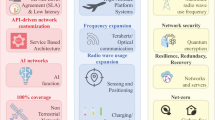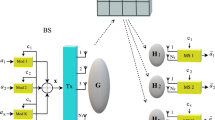Abstract
Multiple input multiple out (MIMO) cognitive radio offer the spatial degree of freedom that can be used to share the spectrum with less interference via Precoding Technique. Many precoding techniques in the literature assume that the underlying hardware is ideal. In the practical case, hardware adds many impairments at both the transmitter and receiver side. Such hardware impairments degrade the performance of the MIMO system. This impairment introduces additional interference to the primary user in minimum interference precoder of MIMO cognitive radio and spoils the objective of the precoder. This paper analyzes the performance of the cognitive radio with minimum interference MIMO precoding in the presence of hardware impairment. Detecting the presence of hardware impairment and its exact variance is required to mitigate the impairment by prewhitening. In general all prewhitening work, it is assumed that the transmitter knows the presence of impairments and the exact variance of it. This work presents support vector machine (SVM) based hardware impairment detection technique on the real-time acquired data by using national instruments, vector signal generator (VSG) 5673. The VSG is configured in 2 × 2 MIMO setup to acquire the transmitter data without impairment and with injected impairment like DC offset, phase noise, I/Q gain imbalance, quadrature skew and frequency offset. After detecting the presence of hardware impairment by SVM, the variance of the data is calculated using Error Vector Magnitude (EVM) to enable prewhitening. The results show that the detection of hardware impairment can be possible with 100% of accuracy and the prewhitening scheme completely removes the impact of it.















Similar content being viewed by others
References
Goldsmith, A., Jafar, S. A., Maric, I., & Srinivasa, S. (2009). Breaking spectrum gridlock with cognitive radios: An information theoretic perspective. Proceedings of the IEEE, 97(5), 894–914.
Zhang, R., & Liang, Y. C. (2008). Exploiting multi-antennas for opportunistic spectrum sharing in cognitive radio networks. IEEE Journal of Selected Topics in Signal Processing, 2(1), 88–102.
Sriram, S., & Sriram, V. (2008). On the capacity of a class of MIMO cognitive radios. IEEE Journal of Selected Topics in Signal Processing, 2(1), 103–117.
Lee, K., Chae, C.-B., Heath, R. W., & Kang, J. (2011). MIMO transceiver designs for spatial sensing in cognitive radio networks. IEEE Transactions on Wireless Communications, 10(11), 3570–3576.
Lee, K.-J., & Lee, I. (2011). MMSE based block diagonalization for cognitive radio MIMO broadcast channel. IEEE Transactions on Wireless Communications, 10(10), 3139–3144.
Amir, M., El-Keyi, A., & Nafie, M. (2011). Constrained interference alignment and the spatial degrees of freedom of MIMO cognitive networks. IEEE Transactions on Information Theory, 57(5), 2994–3004.
Kim, J., Choi, W., Nam, S., & Han, Y. (2014). An efficient prewhitening scheme for MIMO cognitive radio systems. IEEE Transactions on Vehicular Technology, 63(4), 1934–1939.
Kang, M. S., Jung, B. C., Sung, D. K., & Choi, W. (2008). A pre-whitening scheme in a MIMO-based spectrum-sharing environment. IEEE Communications Letters, 12(11), 831–833.
Jung, M., Hwang, K., & Choi, S. (2011). Interference minimization approach to precoding scheme in MIMO-based cognitive radio networks. IEEE Communications Letters, 15(8), 789–791.
Angrisani, L., Moriello, R. S. L., & Vadursi, M. (2009). Measuring time-varying I/Q impairments in digital transmitters. IEEE Transactions on Instrumentation and Measurement, 58(10), 3510–3518.
Jin, Y., & Dai, F. F. (2012). Impact of transceiver RFIC impairments on MIMO system performance. IEEE Transactions on Industrial Electronics, 59(1), 538–549.
Krondorf, M., & Fettweis, G. (2009). Numerical performance evaluation for alamouti space time coded OFDM under receiver impairments. IEEE Transactions on Wireless Communications, 8(3), 1446–1455.
Bjornson, E., Zetterberg, P., Bengtsson, M., & Ottersten, B. (2013). Capacity limits and multiplexing gains of MIMO channels with transceiver impairments. IEEE Communications Letters, 17(1), 91–94.
Matthaiou, M., Papadogiannis, A., Björnson, E., & Debbah, M. (2013). Two-way relaying under the presence of relay transceiver hardware impairments. IEEE Communications Letters, 17(6), 1136–1139.
Dai, X., Zou, R., Sun, S., & Wang, Y. (2013). Transceiver impairments on the performance of the LMMSE-PIC iterative receiver and its mitigation. IEEE Communications Letters, 17(8), 1536–1539.
Zhang, J., Dai, L., Zhang, X., Björnson, E., & Wang, Z. (2016). Achievable rate of Rician large-scale MIMO channels with transceiver hardware impairments. IEEE Transactions on Vehicular Technology, 65(10), 8800–8806.
Zhang, X., Matthaiou, M., Coldrey, M., & Björnson, E. (2015). Impact of residual transmit RF impairments on training-based MIMO systems. IEEE Transactions on Communications, 63(8), 2899–2911.
Sharma, P. K., & Upadhyay, P. K. (2016). Cognitive relaying With transceiver hardware impairments under interference constraints. IEEE Communications Letters, 20(4), 820–823.
Huang, Y., Jiang, H., Hu, H., & Yao, Y. (2009). Design of learning engine based on support vector machine in cognitive radio. In International conference computational intelligence and software engineering (pp. 1–4).
Hu, H., Song, J., & Wang, Y. (2008). Signal classification based on spectral correlation analysis and SVM in cognitive radio. In 22nd international conference on advanced information networking and applications (pp. 883–887).
Keshk, M. E. H. M., El-Naby, M. A., et al. (2015). Automatic modulation recognition in wireless multi-carrier wireless systems with cepstral features. Wireless Personal Communications, 81(3), 1243–1288.
Yang, N. A., Yuan, J. A., Zhou, Y. A., Demirkol, I. B., Duan, Z. A., Heinzelman, W. A., et al. (2017). Enhanced multiclass SVM with thresholding fusion for speech-based emotion classification. International Journal of Speech Technology, 20(1), 27–41.
Garrett, D., Peterson, D. A., Anderson, C. W., & Thaut, M. H. (2003). Comparison of linear, nonlinear, and feature selection methods for EEG signal classification. IEEE transactions on neural systems and rehabilitation engineering, 11(2), 141–144.
Khondoker, M., Dobson, R., Skirrow, C., Simmons, A., & Stahl, D. (2016). A comparison of machine learning methods for classification using simulation with multiple real data examples from mental health studies. Statistical Methods in Medical Research, 25(5), 1804–1823.
Acknowledgements
It is to acknowledge that this work is carried out by utilizing the resources funded under the DST-FIST scheme for Electronics and Communication Engineering department of SRM University, Kattankulathur, Chennai, India.
Author information
Authors and Affiliations
Corresponding author
Rights and permissions
About this article
Cite this article
Ponnusamy, V., Malarvihi, S. Hardware Impairment Detection and Prewhitening on MIMO Precoder for Spectrum Sharing. Wireless Pers Commun 96, 1557–1576 (2017). https://doi.org/10.1007/s11277-017-4256-6
Published:
Issue Date:
DOI: https://doi.org/10.1007/s11277-017-4256-6




